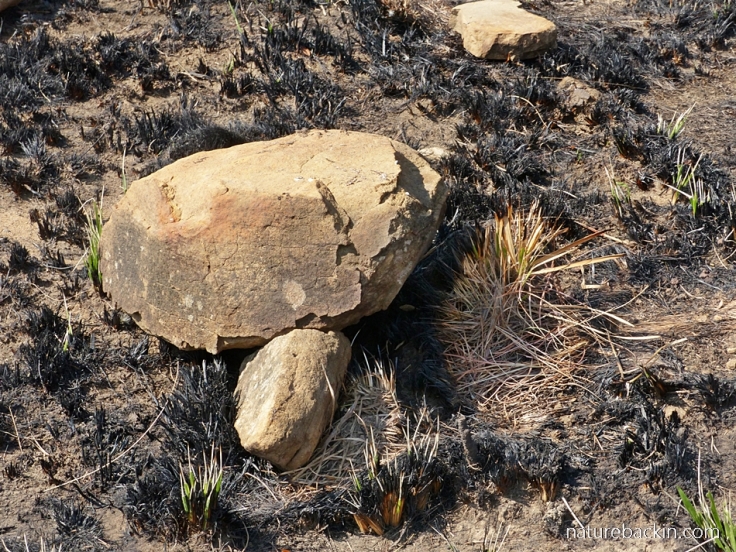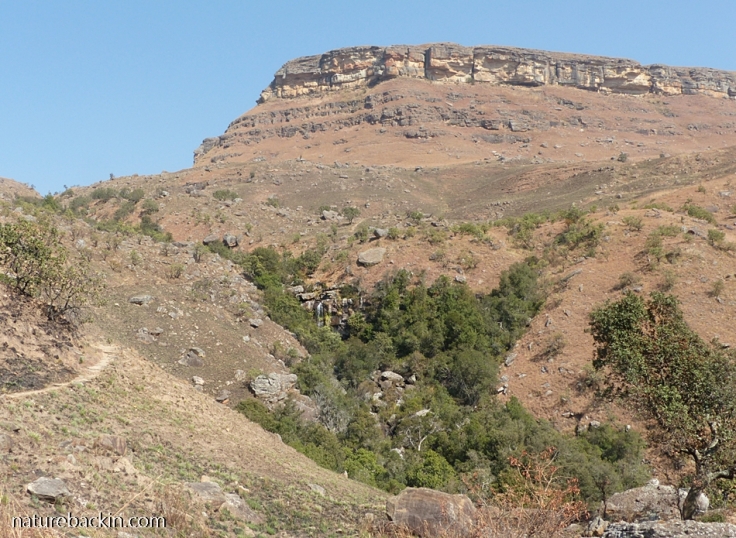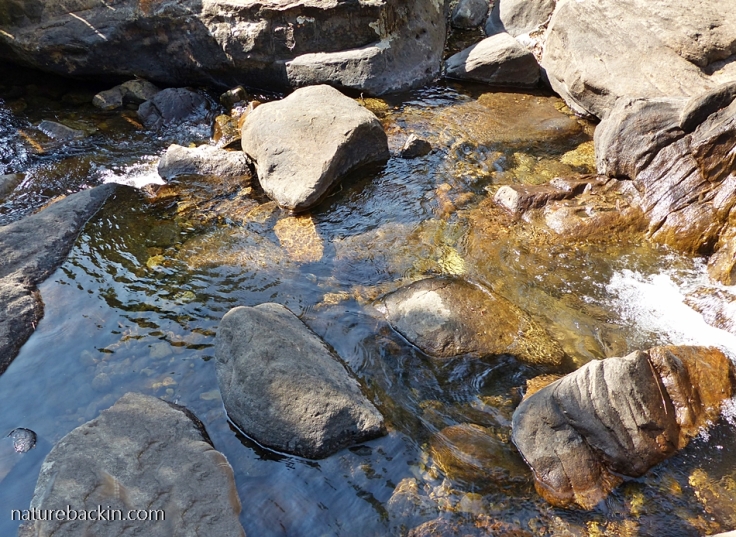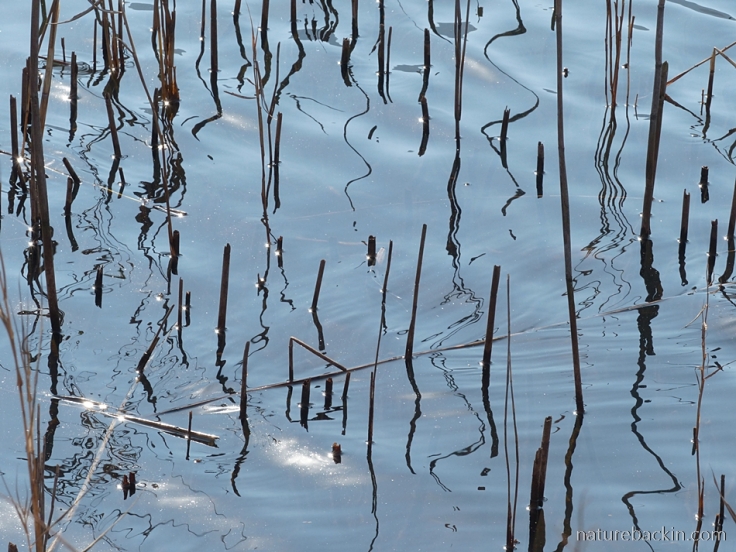Yes that’s right, a hot winter’s day. Yesterday’s high temperature of 28°C intensified the season’s dryness as we found when we ventured forth from suburbia for a walk in the Drakensberg mountains.
Just under two hours’ drive away is Kamberg Nature Reserve where we spent the day with a friend in celebration of her birthday. On the way there we drove through early morning mist heralding the hot day ahead.

We drove through farmlands planted with exotic trees rendered spooky in the early morning mist. Even in a hot dry winter the mistbelt still manages to yield a misty morning or two

The bare trees looked like the ghostly apparitions of many a clichéd storybook

As the sun rose higher the mist dissipated and by the time we started on our walk only a slight haze remained over the dry mountains. Giant’ Castle can just be seen in the background

Near the reception office a Buddleja salvifolia in flower signals imminent springtime
There had been a brief shower of rain the previous week – probably the first rain since May – and possibly even this small amount of rain contributed to the new growth that was erupting through the black ashes of burnt grasses and plants. Many of the plants are fire adapted and regrow in the spring. It is hard to say what effect the mild-to-warm winter (so far) this year has had on plants that are usually dormant through what should be the cold months of winter.

An easy walk lay ahead with only a few short steep or rocky sections as the path meanders through a recent burn from a fire in the reserve
Countrywide, firebreaks burnt in early winter (before 31 July) are used as a management strategy to protect forestry and farmlands and the uncontrolled spread of fires. Fire is also used in the management of different types of natural grasslands including in conservation areas, with ongoing research as to what are the best management strategies for biodiversity and grassland maintenance. However, Ezemvelo KZN Wildlife’s 2012 “Ukhahlamba Drakensberg Park World Heritage Site: Integrated Management Plan” includes among its guiding principles that a patch mosaic of burnt and un-burnt areas should be maintained and that complete burns should not be the objective (p.90).

I do not know if this fire at Kamberg Nature Reserve, which burnt a large area of the park, was part of an annual or biannual managed burn or if the fire resulted from lightning or from arson

A section of the park that has not been subjected to fire so far this winter

Regenerating through the ashes is this tiny Yellow Fire Lily, also known as a Wild Crocus (Cyrtanthus breviflorus). Its bulbs lie underground and so survive the heat of fire

This tuberous grassland plant known as the Lesser Yellow Head (Gnidia kraussiana) is another plant that may flower prominently after a burn. In the photo only one flowerhead is in flower so far. Other stems producing buds are developing and will soon also be in flower. This plant is widely distributed across Africa

The first flowers showing up in the burnt areas were predominantly yellow. These yellow daisy-like plants are gazanias, most probably Gazania krebsiana

Still standing after the fire are the blackened stems of small protea trees. Most protea species are resistant to fire

Singed and dry from being licked by fire this Silver Protea/Sugarbush (Protea roupelliae) is identifiable by the fine silver hairs on the leaves

Growing near a stream these two Grassland Tree Ferns (Cyathea dregei) are also able to withstand fire

On one of the burnt slopes a high percentage of the rocks had been moved revealing flattened patches of unburnt grass matching the shape of each rock. I have been reliably told that baboons foraging for food move or roll over the rocks to find any invertebrates that might have taken refuge underneath during the fire. But what puzzles me is that grass grows underneath the rocks in the first place!

Our destination was this waterfall just visible in this photo within a small ravine where a small forest patch maintains its refuge from fire

This photo was taken when I was looking down into the clear waters of the mountain stream just below the waterfall while we were enjoying coffee and a snack. The stream water is good to drink too – probably the best water I have ever tasted

Looking up from our coffee we watched vultures soaring overhead

Mostly we saw Cape Vultures (as in this photo) but we saw a few White-backed Vultures too
It was very unusual for us to see so many vultures. In one fly-past, we counted a total of 43 vultures, the most we have ever seen in one place. Despite this impressive showing in the relative safety of the mountains, Cape Vultures are listed in The IUCN Red List of Threatened Species as endangered and White-backed Vultures are listed as critically endangered.
We also saw a solitary Bearded Vulture soaring overhead and then skimming along in flight along the edges of the krantzes, but too far off to get a usable photo. When last assessed in 2016, the status of the Bearded Vulture was listed as near threatened.

After our restorative coffee and break we returned along the same path, looking down through the protea trees to the stream flowing below

At the end of our walk, we had a picnic lunch at a small fishing dam just below the Kamberg Nature Reserve hutted camp

We were the only people at the picnic site

I couldn’t resist taking abstract photos of reeds in the sparkly water

And, turning away from the dam, I photographed reeds blown by the wind with a mountain backdrop

As the afternoon wore on a haze returned to the mountains. We heard baboons calling unseen from a nearby krantz, but it was time for us to leave and head back home

On the way home we crossed the upper reaches of the Mooi River. The isolated mountain in the background is the Kamberg. “Kam” refers in Afrikaans to a cock’s comb, which the shape of the mountain resembles

Driving through the nearby farmlands we saw a pair of Wattled Cranes looking for food among the dry mealie stalks. The status of the Wattled Crane is vulnerable. One of the most important causes of egg failure and chick mortality of these winter breeding birds is the winter burning of wetlands. Other winter breeding species can be severely impacted too. Clearly, using fire to manage eco-systems is complex. The timing and frequency of burns needs careful consideration informed by available data in order to try to minimise unintended consequences
Sources:
Boon, Richard. 2010 (2nd ed.). Pooley’s Trees of Eastern South Africa. Durban: Flora & Fauna;
Ezemvelo KZN Wildlife. 2009. Extract from “Guidelines for the in situ Management of Ecosystems in KwaZulu-Natal, according to Biodiversity Conservation Principles”. KZN Biodiversity Stewardship. Report No. L02952/140209/01. https://www.midlandsconservancies.org.za/documents/fire/Ezemvelo%20KZN%20Wildlife%20Stewardship%20wetland%20burning%20guidelines.pdf;
Ezemvelo KZN Wildlife. 2012. “Ukhahlamba Drakensberg Park World Heritage Site: Integrated Management Plan”. http://www.kznwildlife.com/Documents/ApprovedProtectedAreaManagementPlans/ukhahlamba_drakensberg_park_whs_imp_f_14062013.pdf;
Ezemvelo KZN Wildlife. Kamberg Resort. http://www.kznwildlife.com/Kamberg.html;
IUCN. 2019. The IUCN Red List of Threatened Species. https://www.iucnredlist.org/;
Pooley, Elsa. 1998. A Field Guide to Wild Flowers of KwaZulu-Natal and the Eastern Region. Durban: Natal Flora Publications Trust.
Posted by Carol









August 14, 2019 at 2:36 pm
Thanks again for pictures and comments regarding the fires, especially as we have just returned from the Isimangaliso Heritage Site and noticed more burnt areas there than we expected. Kwazulu Natal seems quite dry, at least on the roads we traveled. The Karroo, and some areas towards the West Coast has had an extreme drought for the last six years. Interesting that Nieuwoudtville and surrounds, called the Knersvlakte, one of the driest areas of this country, has had more rain than usual this year. The flowers and bulbs are beginning to bloom and we are expecting a magnificent “flower year” for Namaqualand as well this year. When you have time, have a look at the facebook page of Nieuwoudtville Cape (Hendrik van Zijl) for some pictures,
LikeLiked by 1 person
August 14, 2019 at 6:26 pm
Hi again. Yes it is dry in the region, though slightly less dry in Zululand (I think) than one or two winters ago. At least there is more water in lake St Lucia. The ongoing extreme drought in parts of the Karoo and Eastern Cape is really frightening.
I should think the rains after such a long drought in parts of Namaqualand will produce a wonderful burst of flowers this year. What a fabulous sight that will be, Are you planning a trip there at flower time perhaps? It is likely that the area will be flooded with visitors if this is to be a bumper season. I have looked at some of Hendrik van Zijl’s photos of the flowers – thanks. They are stunning.
LikeLike
August 14, 2019 at 12:27 pm
Enthralling as ever, Carol 🙂 So interesting to learn about those plants which are adapted to withstand burning. Is it simply coincidence that yellow predominates among the first flowers to appear after a fire?
(I love that reed abstract shot!)
LikeLiked by 1 person
August 14, 2019 at 6:10 pm
I think that they were all yellow is a coincidence 🙂 (There are also pinky-white “crocuses” and red fire lilies that I have seen elsewhere in the region after fires.)
Thanks, I took lots of photos of the reeds, but that one stood out from the others.
LikeLiked by 1 person
August 12, 2019 at 2:56 am
Yet another thoroughly enjoyable and informative post! Some of the fire strategies reminded me of what we face here with a nearby wilderness area that is also fire adaptive. I understand we’re still trying to figure out how best to approach wildfire problems. There are some rather diverse opinions on that topic it seems.
Your Wattled Crane is a beauty. It slightly resembles our Sandhill Cranes. And I did like your abstract! I also find it a treat to get some water reflections when I come across them. But the rest of the area looks so very dry.
LikeLiked by 1 person
August 13, 2019 at 11:48 am
Yes, the fire thing is complicated and different objectives can have different protocols that don’t necessarily coincide.
I have just looked up some pics of your Sandhill Cranes and I see the similarity.
Glad you like the water abstract – that was one of several 🙂
It is very dry, so let’s hope spring brings decent rain. There may even be some late winter snow, so here’s hoping as snow is so important for the water table, and there has been very little snow in the mountains this winter.
LikeLike
August 11, 2019 at 3:09 pm
Thank you for this photographic essay. I could smell the burnt land and taste that sweet water
LikeLiked by 1 person
August 13, 2019 at 9:44 am
Thanks Mariss. Yes that smell of dry burnt grassland is very distinctive, and the taste of the mountain water is unique.
LikeLiked by 1 person
August 11, 2019 at 6:12 am
What a nice day out. I particularly like your morning mist photos, the crane, and the reeds abstract – who could resist. Those wide open spaces look like the kind of hikes I’d very much enjoy. The subject of managed burns is very tricky. The west coast of the U.S. have been ravaged by fires these last few years and I’m not sure how much difference managed burns have made to that situation. The only surefire solution is to burn everything in a managed fashion so there’s nothing left to burn out of control, but I’m not sure that would go over well.
LikeLiked by 1 person
August 13, 2019 at 9:43 am
Thanks Graham. I enjoyed the misty shots too (shot through the windscreen while travelling :)).
Re fires, burning firebreaks is legislated for here. Other managed burns can have different conservation objectives, but unfortunately what suits one species or group of species might be detrimental to others so it seems that it can be akin to Russia Roulette, which is why a patch mosaic approach is often recommended, and not burning the entire region annually is preferred.
LikeLiked by 2 people
August 10, 2019 at 1:56 pm
That area is very interesting and I enjoyed your walk. Have you ever been to the top of these mountains? I saw some pictures, they were breathtaking.
LikeLiked by 1 person
August 13, 2019 at 9:39 am
Hi Simone. We used to live nearer to the mountains and often hiked there – mostly along the level of the sandstone cliffs, I have been on top of the Amphitheatre twice (from where the source of the Tugela River falls over the edge in a fall of 948 m making it the second highest waterfall in the world). The view from up there is breathtaking. To get there one goes “up the back” where several chain ladders get one over the very sheer sections. Also on another day hike I nearly got to the top of a more discrete peak (Sterkhorn) but my fear of heights meant I didn’t do the last rather steep and rocky pointy bit 🙂 My husband got to the top with a group of other hikers. To their amazement a hiker in his 80s phoned from the peak and hired a helicopter to come and fetch him – which it duly did! His ambition was to walk to the top, which he did, but he didn’t mind taking a ride down (nor the cost evidently). One other hiker accepted his offer of a lift down 🙂
LikeLike
August 14, 2019 at 9:12 pm
That was one crazy guy! Apart from the certainly expensive price I would have probably also rather let me fly up! 😁 You really are a lucky woman that you have already climbed these great mountains! The Amphitheatre is a dream. It reminds me a little bit of the Quiraing of the Isle of Skye I visited two years ago. The mountain in Scotland is much smaller, but very famous. Some movies like Highlander were shot there.
LikeLiked by 1 person
August 15, 2019 at 8:17 pm
Definitely a crazy guy 🙂 These mountains that I mention involved more a steep walk than an actual climb, but incredibly beautiful nonetheless. I have just looked up the Quiraing mountains and I can see a similarity with the Drakensberg. There is something so special about mountains …
LikeLike
August 16, 2019 at 5:45 am
Definitely!
LikeLiked by 1 person
August 10, 2019 at 2:43 am
Ah Carol, you trigger so many beautiful memories of our own visits to Kamberg with your beautiful photos and eloquent writing.
And I am green with envy about your wattled crane sighting!!!
LikeLiked by 1 person
August 13, 2019 at 9:15 am
Thank you Dries. I hope we do get back there in September and perhaps I will do a post on the vastly different perspective after the spring rains. (We have a had little bit of rain last night and this morning, big yay though!)
It was fantastic to see the pair of wattled cranes so calmly going about their business in the fields.
LikeLiked by 1 person
August 13, 2019 at 9:44 am
Wonderful to hear you’ve had an early sprinkle, Carol! I can’t wait for those first thunderstorms to clear the dust out of Pretoria’s air.
LikeLiked by 1 person
August 13, 2019 at 10:04 am
Definitely something to look forward to.
LikeLiked by 1 person
August 9, 2019 at 8:32 pm
Deserts look empty, but they are certainly teeming with life. I hope the wild and beautiful topography provides adequate refuge for those imperiled species you mentioned.
LikeLiked by 1 person
August 13, 2019 at 8:59 am
Yes, the mountains are a place of refuge for many.
Although the cold night temps, the seasonal dryness (and the little snow this winter) and the recent fires combine to make the mountain region look arid in winter, in fact the region is the most important watershed in southern Africa. It is a high rainfall area in the summer. In the context of my photos taken in dry winter conditions, it is surprising that this mountain region known as the uKhahlamba-Drakensberg Park World Heritage Site is included in the List of Wetlands of International Importance (under the Ramsar Convention)!
LikeLiked by 1 person
August 9, 2019 at 3:34 pm
i really enjoyed the narrative and the photos. i really liked the reeds in the water photo and the wattled crane photo.
LikeLiked by 1 person
August 9, 2019 at 7:25 pm
Thank you very much Buddy. The wattled crane was quite far away and a barbed wire fence intervened so I was surprised that it turned out as it did. It is such a treat to see these birds.
LikeLike
August 9, 2019 at 8:00 pm
😁😁
LikeLiked by 1 person
August 9, 2019 at 2:40 pm
This post reminds me of so many years of visiting the Drakensberg almost every weekend while I studied and worked in KZN. I still miss it. Spent last weekend in Hogsback – it doesn’t hold a candle to the ‘Berg! Controlled burning is a very complex issue as you say. Nonetheless, it is always interesting to see how nature reclaims its own afterwards.
LikeLiked by 1 person
August 9, 2019 at 2:54 pm
We should visit the Drakensberg more often than we manage to do despite it not being that far away. We have resolved to visit again after the spring rains (in anticipation that such rains do occur). Perhaps another post on spring in the mountains is in the offing!
Hogsback is lovely but the scale is somehow different to the ‘Berg as you say.
LikeLike
August 9, 2019 at 10:35 am
A lovely description of your day at Kamberg Carol! There seem to be many more uncontrolled fires this season, perhaps because it is so dry. Baboons are continually moving rocks in search of food, so entirely possible that some had been moved onto grass before the fire, and then again afterwards. I love Kamberg, and yes, it seems not many visit there. xxx
LikeLiked by 1 person
August 9, 2019 at 2:46 pm
Thanks Christeen. Kamberg really deserves to be visited for lots of reasons. The rock art alone is reason enough to visit!
Interesting what you note about the baboons moving the rocks back and forth continually in their search for food. It makes sense what you say. The moving of the rocks is only really noticeable to us after a burn.
Yes the dryness and fire risks are very worrying. It is cooler here today and it pretended to rain in the night but not enough to wet the ground but early days yet, I guess.
LikeLiked by 1 person
August 9, 2019 at 10:19 am
I have occasionally wondered about so called ”managed burns”. What happened before humans arrived?
LikeLiked by 1 person
August 9, 2019 at 10:41 am
Before these areas were managed there were natural fires, mainly caused by lightning during ‘dry’ thunderstorms at the beginning of Spring. Our KwaZulu-Natal Drakensberg vegetation is a fire induced eco-system, the main reason, why apart from in protected gullies, there are few trees. The exception, as Carol wrote, are the Protea species, as they are fire resistant.
LikeLiked by 3 people
August 9, 2019 at 2:38 pm
Yes one does wonder about the need for “management” when lightning can cause natural fires. I gather though that a high percentage of natural grasslands have disappeared forever, and much of what remains is under pressure from livestock grazing, invasion by bracken etc, and other factors that accompany large-scale human settlement, urbanisation, forestry and farming. Only 3% of natural grasslands in SA are protected and have to be proactively maintained/conserved and fire is one of the tools that prevents them from becoming thickets and most grasses and other grassland plants are adapted to fire – just to add to Christeen’s comment. Nevertheless, fire is tricky as the timing etc varies across sometimes competing objectives and needs of different species.
LikeLiked by 4 people
August 9, 2019 at 8:09 am
What a wonderful walk. Fire is used as a management technique, particularly on moorland here too. But the last few years have seen a devastating rise in uncontrollable fires put down to arson. And those vultures? 43? You weren’t trying! You should try la Rioja in Spain. I’ve never seen numbers like it – griffon vultures apparently. Your photos are, as ever, evocative.
LikeLiked by 1 person
August 9, 2019 at 2:23 pm
And I guess the hotter drier conditions that prevail in so many places are an arsonists dream come true.
The vultures in Spain sound like something to see 🙂
LikeLiked by 1 person
August 9, 2019 at 2:40 pm
Definitely. Quite enthralling.
LikeLiked by 1 person
August 9, 2019 at 8:02 am
I really enjoyed my visual walk with you through the Drakensberg! One of my favourite areas on earth.
Thank you.
I will reply to your email as soon as I feel strong enough to re-read its unwelcome reminder of our impending doom in order to reply.
Love from your avoidant friend.
Jill
LikeLiked by 1 person
August 9, 2019 at 2:21 pm
Thanks Jill. I also love the Drakensberg.
Shew, just press the delete button on that email (I should have done that). It reflected me being shaken and somewhat stirred and should be ignored 🙂 I have since reset …
xxx
LikeLike
August 9, 2019 at 7:59 am
Thank you for sharing your images, these are truly beautiful.
LikeLiked by 1 person
August 9, 2019 at 2:15 pm
Thank you so much Isabel. It was nice to choose some images to share.
LikeLike